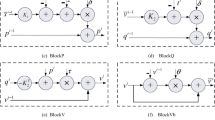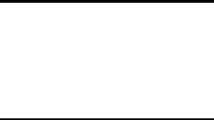Abstract
In this work, we introduce a bilevel problem based on fractional-order total variation for image denoising. A deep learning architecture is provided in the upper model to strengthen the regularization term in the lower one. Numerical results show the efficacy of the proposed approach, compared to various competitive models.












Similar content being viewed by others
References
Hamalainen K, Kallonen A, Kolehmainen V, Lassas M, Niinimaki K, Siltanen S (2013) Sparse tomography. SIAM. J Sci Comput 35(3):644–665
Girard DA (1987) Optimal regularized reconstruction in computerized tomography. SIAM J Sci Stat Comput 8(6):934–950
Hsieh J, Nett B, Yu Z, Sauer K, Thibault J-B, Bouman CA (2013) Recent advances in ct image reconstruction. Curr Radiol Rep 1(1):39–51
Rudin LI, Osher S, Fatemi E (1992) Nonlinear total variation based noise removal algorithms. Phys D Nonlinear Phenom 60(1–4):259–268
Taheri S, Gasparovic C, Shah NJ, Rosenberg GA (2011) Quantitative measurement of blood-brain barrier permeability in human using dynamic contrast-enhanced mri with fast t1 mapping. Magn Reson Med 65(4):1036–1042
Zhang K, Zuo W, Gu S, Zhang L (2017) Learning deep cnn denoiser prior for image restoration. In: Proceedings of the IEEE Conference on Computer Vision and Pattern Recognition, p 3929–3938
Lucas A, Iliadis M, Molina R, Katsaggelos AK (2018) Using deep neural networks for inverse problems in imaging: beyond analytical methods. IEEE Signal Proc Mag 35(1):20–36
McCann MT, Jin KH, Unser M (2017) Convolutional neural networks for inverse problems in imaging: A review. IEEE Signal Proc Mag 34(6):85–95
Chung J, Español MI (2017) Learning regularization parameters for general-form tikhonov. Inverse Problems 33(7):074004
Hansen PC (1989) Regularization, gsvd and truncated gsvd. BIT Numer Math 29:491–504
Laghrib A, Ben-Loghfyry A, Hadri A, Hakim A (2018) A nonconvex fractional order variational model for multi-frame image super-resolution. Signal Process Image Commun 67:1–11
Ben-Loghfyry A, Hakim A, Laghrib A (2023) A denoising model based on the fractional beltrami regularization and its numerical solution. J Appl Math Comput 69(2):1431–1463
Ben-Loghfyry A, Hakim A (2022) Time-fractional diffusion equation for signal and image smoothing. Math. Modeling and Comput 9(2):351–364
Al-Mahdi A, Fairag F (2018) Block diagonal preconditioners for an image de-blurring problem with fractional total variation. In: Journal of Physics: Conference Series, vol 1132, p 012063. IOP Publishing
Li Y, Qin J, Osher S, Liu W (2016) Graph fractional-order total variation eeg source reconstruction. In: 2016 38th Annual International Conference of the IEEE Engineering in Medicine and Biology Society (EMBC), pp 101–104. IEEE
Zhao W, Lu H (2017) Medical image fusion and denoising with alternating sequential filter and adaptive fractional order total variation. IEEE Trans Instrum Meas 66(9):2283–2294
Zhang J, Chen K (2015) A total fractional-order variation model for image restoration with nonhomogeneous boundary conditions and its numerical solution. SIAM J Imaging Sci 8(4):2487–2518
Ben-Loghfyry A, Hakim A, Laghrib A (2022) A denoising model based on the fractional beltrami regularization and its numerical solution. J Appl Math Comput, 1–33
Ben-loghfyry A, Hakim A (2022) Reaction-diffusion equation based on fractional-time anisotropic diffusion for textured images recovery. Int J Appl Comput Math 8(4):177
Hakim A, Ben-Loghfyry A (2019) A total variable-order variation model for image denoising. AIMS MATHEMATICS 4(5):1320–1335
Ben-loghfyry A, Hakim A (2023) Total variable-order variation as a regularizer applied on multi-frame image super-resolution. The Visual Computer, 1–11
Baloochian H, Ghaffary HR, Balochian S (2017) Enhancing fingerprint image recognition algorithm using fractional derivative filters. Open Comput Sci 7(1):9–16
Ferrah I, Chaou AK, Maadjoudj D, Teguar M (2020) Novel colour image encoding system combined with ann for discharges pattern recognition on polluted insulator model. IET Science, Measurement & Technology
Nasreddine K, Benzinou A, Fablet R (2009) Signal and image registration: Application to decrypt marine biological archives. TRAITEMENT DU SIGNAL 26(4):255–268
Frohn-Schauf C, Henn S, Witsch K (2008) Multigrid based total variation image registration. Comput Vis Sci 11(2):101–113
Magiera J, Ray D, Hesthaven JS, Rohde C (2020) Constraint-aware neural networks for riemann problems. J Comput Phys 409:109345
Hintermüller M, Wu T (2015) Bilevel optimization for calibrating point spread functions in blind deconvolution
Chen Y, Pock T (2016) Trainable nonlinear reaction diffusion: A flexible framework for fast and effective image restoration. IEEE Trans Pattern Anal Mach Intell 39(6):1256–1272
Kunisch K, Pock T (2013) A bilevel optimization approach for parameter learning in variational models. SIAM J Imaging Sci 6(2):938–983
Chung J, Español MI, Nguyen T (2014) Optimal regularization parameters for general-form tikhonov regularization. arXiv preprint arXiv:1407.1911
Ring W (2000) Structural properties of solutions to total variation regularization problems. ESAIM: Math Model Numer Anal 34(4):799–810
Ben-loghfyry A, Hakim A (2023) Caputo fractional-time of a modified cahn-hilliard equation for the inpainting of binary images. Journal of Mathematical Modeling
Song Y, Ermon S (2019) Generative modeling by estimating gradients of the data distribution. Advances in neural information processing systems 32
Bilgic B, Chatnuntawech I, Fan AP, Setsompop K, Cauley SF, Wald LL, Adalsteinsson E (2014) Fast image reconstruction with l2-regularization. J Magn Reson Imaging 40(1):181–191
Javed SG, Majid A, Mirza AM, Khan A (2016) Multi-denoising based impulse noise removal from images using robust statistical features and genetic programming. Multimed Tools Appl 75:5887–5916
Tian C, Zheng M, Zuo W, Zhang B, Zhang Y, Zhang D (2023) Multi-stage image denoising with the wavelet transform. Pattern Recogn 134:109050
Wu Q (2023) Research on deep learning image processing technology of second-order partial differential equations. Neural Comput & Applic 35(3):2183–2195
Ben-loghfyry A, Hakim A (2022) Robust time-fractional diffusion filtering for noise removal. Math Meth Appl Sci 45(16):9719–9735
Zhang C, Zhang Z, Feng Z, Yi L (2023) Joint sparse model with coupled dictionary for medical image fusion. Biomed Signal Process Control 79:104030
Tabassum S, Gowre SC (2023) Optimal image denoising using patch-based convolutional neural network architecture. Multimedia Tools and Applications, 1–17
Liu X, Hao C, Su Z, Qi Z, Fu S, Li Y, Han H (2023) Image inpainting algorithm based on tensor decomposition and weighted nuclear norm. Multimedia Tools and Applications 82(3):3433–3458
Zhang T-T, Shu H, Lam K-Y, Chow C-Y, Li A (2023) Feature decomposition and enhancement for unsupervised medical ultrasound image denoising and instance segmentation. Appl Intell 53(8):9548–9561
Sui J, Ma X, Zhang X, Pun M-O (2023) Gcrdn: Global context-driven residual dense network for remote sensing image super-resolution. IEEE Journal of Selected Topics in Applied Earth Observations and Remote Sensing
Shi Y, Huang Z, Huang Z, Hua X, Hong H, Li L (2023) Hinrdnet: A half instance normalization residual dense network for passive millimetre wave image restoration. Infrared Physics & Technology 132:104722
Liang J, Cao J, Sun G, Zhang K, Van Gool L, Timofte R (2021) Swinir: Image restoration using swin transformer. In: Proceedings of the IEEE/CVF International Conference on Computer Vision, pp 1833–1844
Zhang Y, Tian Y, Kong Y, Zhong B, Fu Y (2020) Residual dense network for image restoration. IEEE Trans Pattern Anal Mach Intell 43(7):2480–2495
Singh H, Ahmed AS, Melandsø F, Habib A (2023) Ultrasonic image denoising using machine learning in point contact excitation and detection method. Ultrasonics 127:106834
Vaksman G, Elad M (2023) Patch-craft self-supervised training for correlated image denoising. In: Proceedings of the IEEE/CVF Conference on Computer Vision and Pattern Recognition, pp 5795–5804
Liu Y, Qin Z, Anwar S, Ji P, Kim D, Caldwell S, Gedeon T (2021) Invertible denoising network: A light solution for real noise removal. In: Proceedings of the IEEE/CVF Conference on Computer Vision and Pattern Recognition, pp 13365–13374
Kulikov V, Yadin S, Kleiner M, Michaeli T (2023) Sinddm: A single image denoising diffusion model. In: International Conference on Machine Learning, pp. 17920–17930. PMLR
Arun P, Sahare SA, Gopi VP (2023) Rescownet: A deep convolutional neural network with residual learning based on dt-cwt for despeckling optical coherence tomography images. Optik 284:170924
Stergiopoulou V, Mukherjee S, Calatroni L, Blanc-Féraud L (2023) Fluctuation-based deconvolution in fluorescence microscopy using plug-and-play denoisers. In: International Conference on Scale Space and Variational Methods in Computer Vision, pp 498–510. Springer
Liu D, Wang J, Shan Q, Smyl D, Deng J, Du J (2023)Deepeit: deep image prior enabled electrical impedance tomography. IEEE Transactions on Pattern Analysis and Machine Intelligence
Chen W, Wipf D, Rodrigues M (2021) Deep learning for linear inverse problems using the plug-and-play priors framework. In: ICASSP 2021-2021 IEEE International Conference on Acoustics, Speech and Signal Processing (ICASSP), pp 8098–8102. IEEE
Mazé F, Ahmed F (2023) Diffusion models beat gans on topology optimization. In: Proceedings of the AAAI Conference on Artificial Intelligence (AAAI), Washington, DC
Ho J, Saharia C, Chan W, Fleet DJ, Norouzi M, Salimans T (2022) Cascaded diffusion models for high fidelity image generation. J Mach Learn Res 23(1):2249–2281
Kawar B, Ganz R, Elad M (2022) Enhancing diffusion-based image synthesis with robust classifier guidance. arXiv preprint arXiv:2208.08664
Elad M (2002) On the origin of the bilateral filter and ways to improve it. IEEE Trans Image Process 11(10):1141–1151
Bredies K, Kunisch K, Pock T (2010) Total generalized variation. SIAM J Imaging Sci 3(3):492–526
Zhang K, Zuo W, Chen Y, Meng D, Zhang L (2017) Beyond a gaussian denoiser: Residual learning of deep cnn for image denoising. IEEE Trans Image Process 26(7):3142–3155
Zhang K, Zuo W, Zhang L (2018) Ffdnet: Toward a fast and flexible solution for cnn-based image denoising. IEEE Trans Image Process 27(9):4608–4622
Li Y, Zhang J, Wang M (2017) Improved bm3d denoising method. IET Image Process 11(12):1197–1204
Acknowledgements
We would like to thank the editor and anonymous reviewers for their helpful comments and valuable suggestions.
Author information
Authors and Affiliations
Corresponding author
Ethics declarations
Consent for publication
Not applicable.
Competing interests
The authors declare that they have no competing interests.
Additional information
Publisher's Note
Springer Nature remains neutral with regard to jurisdictional claims in published maps and institutional affiliations.
Rights and permissions
Springer Nature or its licensor (e.g. a society or other partner) holds exclusive rights to this article under a publishing agreement with the author(s) or other rightsholder(s); author self-archiving of the accepted manuscript version of this article is solely governed by the terms of such publishing agreement and applicable law.
About this article
Cite this article
Ben-loghfyry, A., Hakim, A. A bilevel optimization problem with deep learning based on fractional total variation for image denoising. Multimed Tools Appl 83, 28595–28614 (2024). https://doi.org/10.1007/s11042-023-16583-4
Received:
Revised:
Accepted:
Published:
Issue Date:
DOI: https://doi.org/10.1007/s11042-023-16583-4




